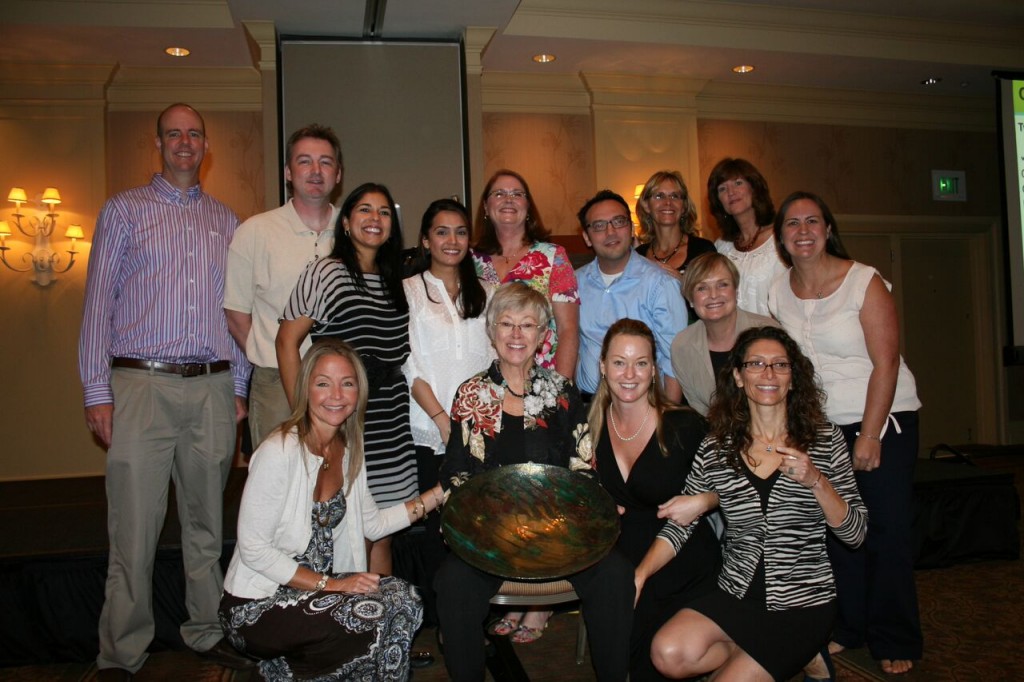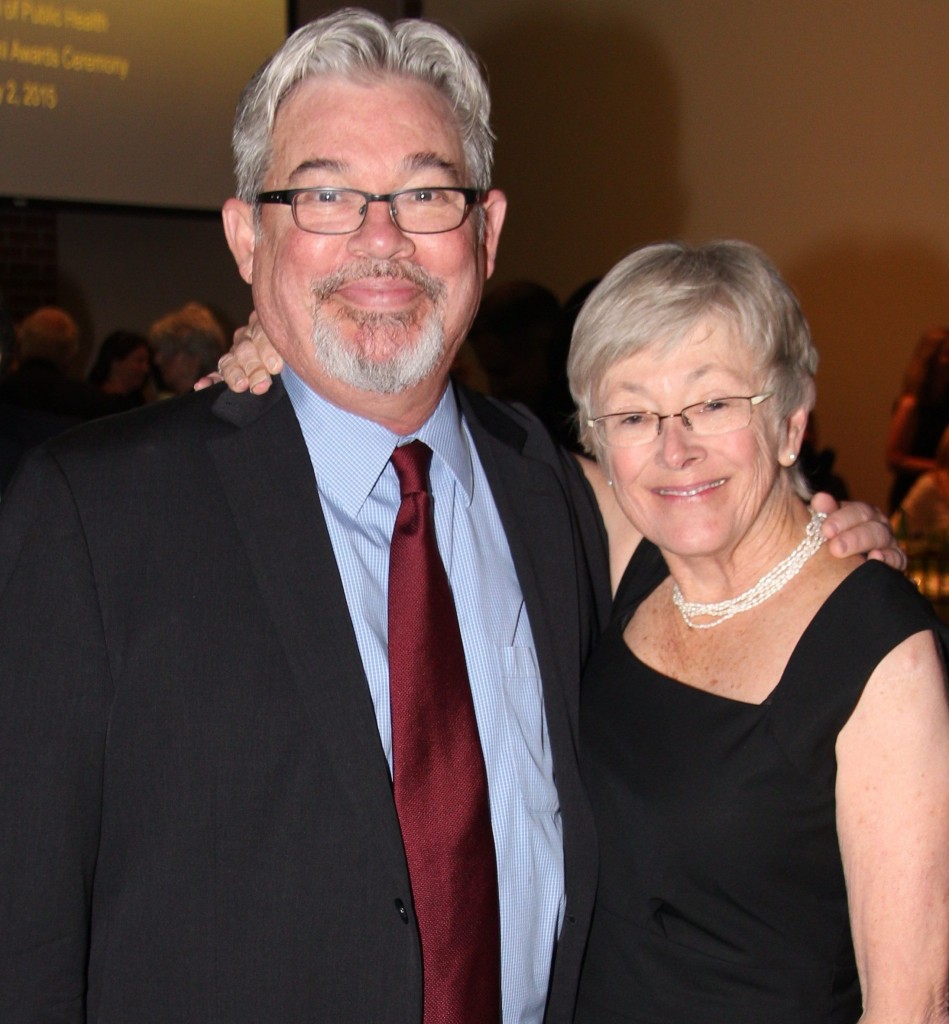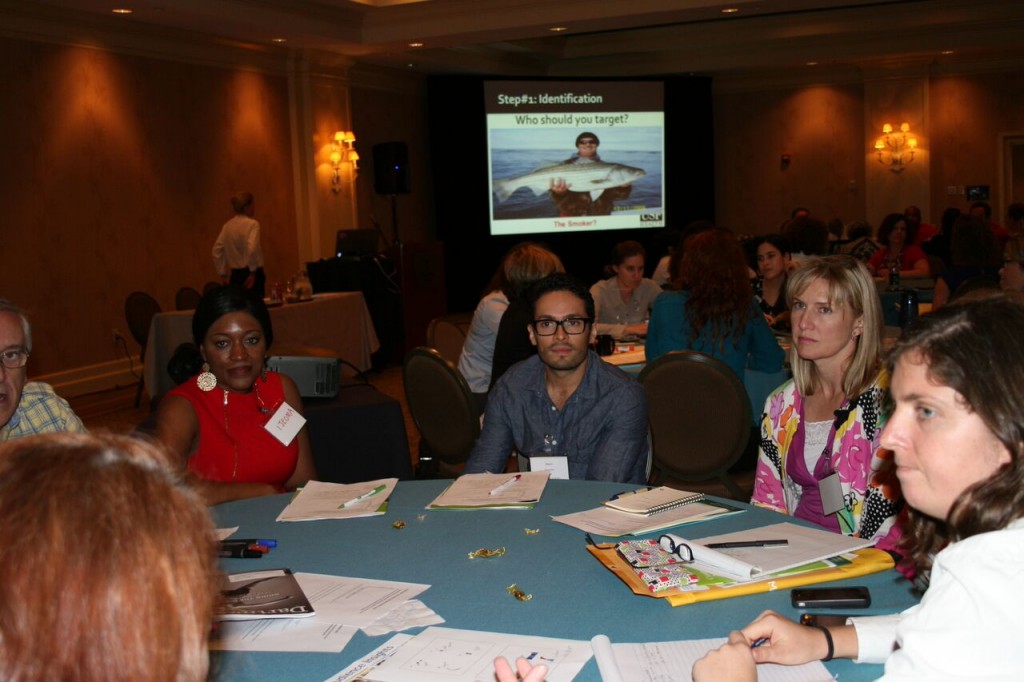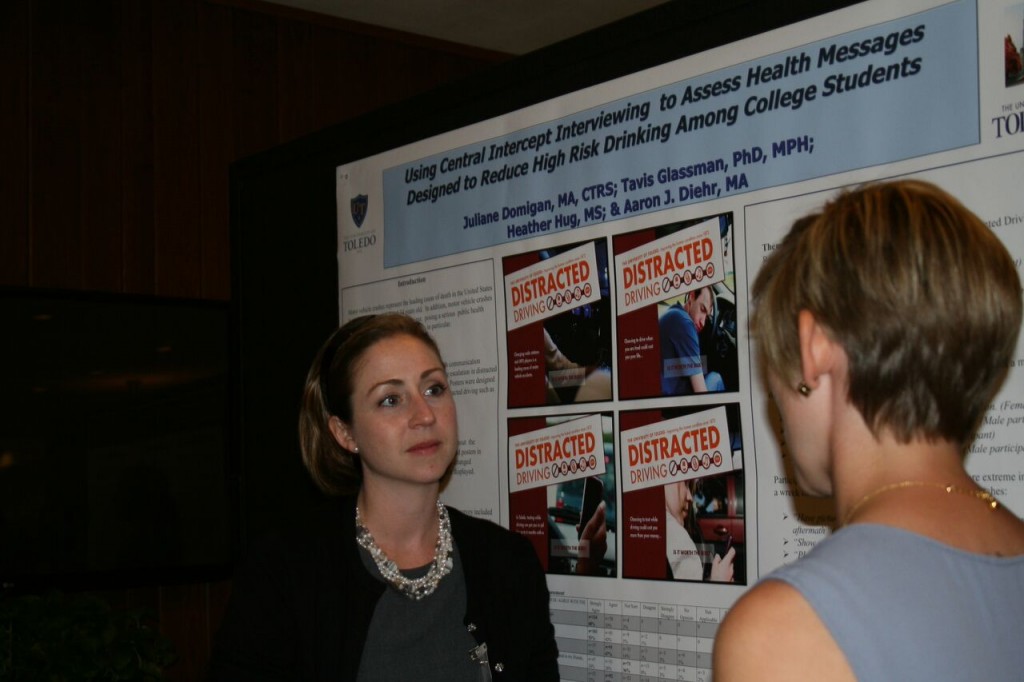Pioneers of social marketing discuss its founding and its future
First published on June 1, 2015 in observance of the COPH’s 30th anniversary celebration.
Dr. Carol Bryant was on the ground floor of the USF College of Public Health’s social marketing program when the social marketing field was in its infancy. She credits Dr. Stan Graven, chair of the Department of Community and Family Health at the time, for the idea of a social marketing conference.
“He asked me to start a conference,” Bryant said. “He said, ‘I think the field of social marketing has enough popularity and potential. We need a conference on it.’”
Bryant, now USF Distinguished Health Professor in Community and Family Health, believes Graven’s own conference had convinced him of the viability of conferences in general, and specifically their ability to facilitate broad networking among stakeholders in any given field.
“It’s had a really major impact on his field,” Bryant said of what has become known as the Gravens conference, “so he could see that a conference in social marketing might be able to do the same thing. He realized that a national conference could bring people together, disseminate the ideas, make a significant contribution to the public health community, and probably be good for branding USF.”
Bryant assented despite never having done anything of the kind or having any real idea of how to go about it.
She enlisted the help of Judy Sommers, who was at that time in charge of organizing COPH events. She traveled to the nation’s capital to consult with two people at CDC who were well known in social marketing to ask whom to invite to speak. She even began to think that putting a conference together might not be so difficult, after all.
“We had a really dynamic lineup of all the really active social marketers in the United States,” she said. “We paid them all for their travel and a pretty good honorarium to come. We promoted the conference, and we had 71 people.”
So far, so good. There was just one problem.
“Forty or 50 of them were speakers,” she recalled, “so we lost a bundle of money.”
Bryant concluded then that the inaugural social marketing conference would also be the last, but she had a believer in Graven.
“Stan had the vision and courage to say, ‘Nope, we’re going to do it again. Only this time, we’re not going to lose money, so let’s see how we can cut back on the budget and do better promotion.’”

Flanked by a cadre of congratulatory colleagues, Bryant (center) received a special recognition they presented her at the 2014 Social Marketing Conference.
The result was a second conference that turned the tide. Smaller honoraria and fewer speakers fixed the early financial faux pas, along with the discovery within a few years that the honoraria could be dropped altogether. There was enough interest in social marketing and enough respect for the conference that speakers would pay their own way to take part, and holding it at a beachfront resort didn’t hurt.
“Stan was absolutely right,” Bryant said. “The conference would take the approach of social marketing and disseminate it in a way we couldn’t just through publications and my flying around and talking about it.”
Still, she said, social marketing’s early days at USF were lean at best.
“The early days were real tough financially,” she said. “I was pretty terrified, actually, about how to do something like this. Fortunately, we had good people – first Judy Sommers and then Ginger Phillips, and now Bobbi Rose – to do all the conference planning, but I didn’t realize I could just sit back and let them do that. In the first years, I felt like, ‘Oh, my gosh, I have to learn how to do this.’”
In those early years, the Social Marketing Conference, the first of its kind anywhere, was pretty much the extent of social marketing, said Bryant, who also co-directs the Florida Prevention Research Center, a CDC-funded entity that develops and evaluates a community-based approach to social marketing.
“We did not have what we came to call the training academy yet, or the field school,” she said. “I think I was teaching an Introduction to Social Marketing course at that time.”
Persistence pays
Bryant’s long-time social marketing partner is also her long-time partner in the bigger sense, her husband, James Lindenberger, director and faculty administrator of the Social Marketing Group. When social marketing was launched at COPH, Lindenberger was not yet at USF, but was nonetheless a major catalyst in the start of social marketing at the university. Together, he and Bryant founded Best Start Social Marketing, a nonprofit marketing agency with an innately symbiotic relationship with social marketing at USF. Lindenberger was its executive director for its first 15 years. He also is founder and former publisher of Social Marketing Quarterly, the first peer-reviewed journal dedicated to social marketing.
“Much of the work that we did, whether at our agency or at USF, was really done collaboratively between the two,” Lindenberger recalled. While agreeing that the Social Marketing Conference drove at least the USF entry into the field, and probably more, he shared Bryant’s recollection of a shaky start.
“It was the first conference we’d ever put on,” he said. “We didn’t know what we were doing, exactly, but we did have a lot of people who were instrumental in the field of social marketing, which was still a very young discipline. We had a lot of what we thought were the important folks in the field do the presentations.”
One of those people, Lindenberger said, was Alan Andreasen, now a marketing professor at Georgetown University and executive director of the Social Marketing Institute.
“We asked him to be the closing speaker and add an exclamation point to the conference,” Lindenberger said. “So, after a day-and-a-half of presentations, Alan got up and said, ‘Well, I want to tell you all that none of you know what social marketing is. You’re completely wrong.’ He then proceeded to spend about 35 or 40 minutes telling us how much we had messed up.”
Bryant and Lindenberger laughed heartily as they recalled the incident, but said they were far from finding it amusing at the time.
“We were furious. You left the room,” Lindenberger said, nodding to Bryant, who agreed.
“I got up,” she said, “and was just pacing in the hallway thinking, ‘I can’t take this.’”
“We were really furious,” Lindenberger continued, “because this is a guy who was really important, and a lot of people looked to him, and we wanted him to come in and say, ‘Bless you. Thank you for doing this. Nobody else has done it before. We appreciate it.’ Instead, he got up and basically said, ‘You idiots.’
“After a few weeks of us getting through this, it dawned on us that he was right. His concern was that we had had almost all communications presentations. Almost everything we talked about was promotion. He said, ‘That’s not what we’re about. We aren’t advertisers, we’re marketers, and marketers do a complete and holistic look at solving problems and apply those different variables to the solutions.’”
What resulted, Lindenberger said, was a dramatic redesign of the conference for the following year.

Holding a conference at a seaside resort is a good thing, as the faces of Social Marketing Conference attendees show.
“It’s been interesting,” Bryant noted. “That mistake was made by almost everyone we invited. They showed off all their promotional materials and were very proud to do so, and we still have trouble with trying to make sure people don’t do that, and that our audience understands that it isn’t just advertising.
“It’s very humbling that people can sit there for two days having us tell them that maybe 20 times and still try to hire us to do TV ads. I think it’s because most people think marketing is advertising. It’s a hard misunderstanding to correct.”
In fact, both said the term “social marketing” has long been problematic. Technology, it might seem, is doing all it can to keep it that way.
“It’s interesting,” Bryant said. “It’s changed from ‘Don’t call it that, because marketing is evil’ or ‘Don’t call it social marketing, because that’s social engineering.’ Now, it’s a different debate.”
“A lot of the debate,” Lindenberger said, “seems to be rooted in younger folks coming into the field who do want to be social marketers, but when they present themselves as social marketers to their peers, their bosses or their clients, those people misinterpret that to mean social media and social media marketing. Their concern is that it’s diminishing their ability to have an impact and also diminishing their ability to have a successful career.”
“For many of us who are kind of the old guard on this,” he continued, “our belief is there’s just so much brand equity built into it. There’s a huge array of publications and organizations and conferences that are built around social marketing. We would have another 30 years of building the brand up.”
“But we already have lost a lot of brand equity,” Bryant countered. “If you Google ‘social marketing,’ you’ll get social media, even social media marketing conferences. It is a real problem.
“In the U.S. public health system, and certainly within anthropology, it was seen as advertising and manipulation,” added Bryant, an anthropologist by training. “I had anthropology friends who just thought I had gone totally to the dark side, but public health had a real misunderstanding about it, too, until people like Marsha Walker in Texas got it right and funded a really successful program. That program was so successful that soon, the other agencies were asking us to do projects for them. So, as they saw it work in this country, people in public health went, ‘Wait a minute. Whatever it’s called, this might work for us.”
“I think what happened here at USF is a very significant part of why the discipline grew as rapidly and as successfully as it did,” Lindenberger said. “A national program that we did out of USF and Best Start was the national breastfeeding promotion campaign for the Department of Agriculture. That became their national brand. It’s been used in every state in the country, is still being used, and that really brought social marketing to the foreground in Washington in a way domestically that it had never been before.”
Throw me a line
That early show of strength by the program also was a very early sign of things to come for the field, “upstream” social marketing, an approach that wouldn’t have a name for many years.
“Downstream is basically going to the individual or small group to influence their behaviors to be more positive in a particular issue, health issue or whatever it may be,” Lindenberger explained. “Upstream is trying to look at the environment, decision-makers and the other factors that actually create a situation in which people can make change more effectively and more usefully.”
“All these people are drowning in the river downstream,” Bryant offered by way of the prevailing example in the field. “So, you throw them educational pamphlets on how to swim or pull them out one at a time. But upstream says, ‘No, let’s find out where they’re coming from. Is there a bridge that’s broken? Is something giving way? Let’s go up there and keep them getting into the river in the beginning, instead of one by one educating them on how to survive.’ It’s a powerful metaphor, and it is catching on.”
Lindenberger noted that early applications of upstream social marketing significantly predate the metaphor. While the national breastfeeding campaign was being developed in 1989, he said, Bryant and a pair of colleagues went to Capitol Hill and lobbied Congress for funding.
“It had never been done before,” Lindenberger said, “and after that lobbying effort, $8-million was set aside specifically for breastfeeding promotion and management to be dispersed throughout the country in the WIC program. That was upstream. The very first project we ever did was as upstream as it gets.”
Bryant credits Andreasen for helping to widely disseminate the metaphoric term – source unknown – that has become a directional imperative for social marketing over the past decade, as well as numerous others for driving it forward.
“Many speakers at our conference, Bill Smith and Gerard Hastings from Scotland, especially, brought that metaphor alive for us and nudged us to go more upstream,” Bryant said, “and then our critics like Larry Wallach were saying the same thing,” which was that the downstream approach was blaming the victims, chiding them for not knowing how to swim well enough to save themselves.
“All those forces came together at the same time, and public health had the same realization. We said, ‘Wait a minute. We’d be really stupid to keep going downstream. Let’s come up with a model that takes social marketing upstream,’ so that’s what we’ve done for the last 10 years – develop the model and test it out, and now, we’re training people in it.
“I’m hoping it will really take off. It is more difficult to get funding, but it is more sustainable, too.”
This year, social marketing at USF COPH added to its impressive list of accolades the nation’s first MPH with a social marketing concentration. Last year, the program celebrated the revision and re-launch of its social marketing training web site in conjunction with the Florida Prevention Research Center. There is excitement over the field’s burgeoning relationships with other disciplines, namely engineering (humanitarian engineers) and a long-standing but still growing symbiosis with anthropology. There also is that strengthening upstream trend.
Which way do we go?
But with all its successes, expansion, diversification and partnering, social marketing nonetheless remains a relatively new field in a time when a digital communications explosion can threaten to turn almost anything into a shape-shifter. While few would argue that 44 successful years likely points toward anything less than a positive future, identifying potential threats can hardly be seen as unwise.
So, just where is social marketing headed? In arguably its adolescence, what will it look like fully grown? Who better to ask than two people who have nurtured it from infancy?
“I see a lot of dangers ahead,” Bryant said, “the big one being the brand equity diminishing because of confusion with social media marketing, and I’m not sure where I stand on the argument. But I’m at this point kind of leaning toward maybe we do change our name, or do a qualification to it, ‘social marketing for behavior change,’ or something like that to help clarify that we’re not social media.
“Like anything, it peaks and then it falls,” she said, “and I resisted doing an MPH in social marketing, because I was afraid it was just an approach and its popularity might wane, and people with that degree – other people wouldn’t even know what they did. I think those are some dangers that are real, but there are now so many people active in the field around the world. We have two list serves, two journals, two conferences, and we’re thousands strong instead of just a hundred, so I think those fears are probably not warranted.”
“I agree with that,” Lindenberger offered. “They’re not warranted. We differ over the name issue and social media marketing. I’m fairly comfortable with the fact that people sometimes get confused, and we can help them learn more about it if we have the chance to engage them. And I also don’t really care. I think we and other social marketers continue to do what we do, and if we do it well, if we produce the product successfully and deliver something to their audiences that they really need and want that will help them accomplish their own missions, then we’re fine.”
After discussing the future they anticipate for social marketing, it was time to consider the one they’d like to see.
“Something I think will happen – we’re already seeing it – that I would like more of is social marketing moving out of public health,” Bryant said. “I think our conference taught people in public health how to apply social marketing. Only more recently have we attracted people from other fields and changed our name from Social Marketing in Public Health to just Social Marketing Conference.
“It since then has also taken off in environmental protection. A man named Doug McKenzie Moore, who’s a good trainer and has a wonderful web site and a list serve, has really spread it around the world for people who are working in recycling and all kinds of things. We’re working with Qatar now to do the same thing in transportation. Some social marketers want to see it in finance helping people to manage their finances better.
“So, what I’m hoping happens is it really does move out of just public health applications, because it could work so well in other arenas. Healthy People 2020 has a set of objectives related to social marketing, and they want to see, by 2020, more health departments using social marketing. I’d like to see state health departments really use it. And the other set of objectives in Healthy People 2020 is that all schools of public health will offer at least a course in social marketing.”
“I’d like to see it be a degree program in a lot of universities around the country,” Lindenberger said. “I think that would be a way for this to really take off – that people see it as a legitimate credential that helps them get jobs and provides them with tools to be able to influence positive change.”
Story by David Brothers, College of Public Health.





